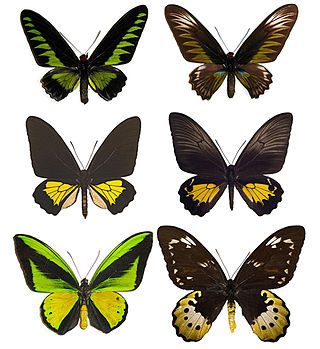
Birdwings are butterflies in the swallowtail family, that belong to the genera Trogonoptera, Troides, and Ornithoptera. Most recent authorities recognise 36 species, however, this is debated, and some authorities include additional genera. Birdwings are named for their exceptional size, angular wings, and birdlike flight. They are found across tropical Asia, mainland and archipelagic Southeast Asia, and Australasia.

Ornithoptera alexandrae, the Queen Alexandra's birdwing, is the largest species of butterfly in the world, with females reaching wingspans slightly in excess of 25 cm to 28 cm. This birdwing is restricted to the forests of the Oro Province in eastern Papua New Guinea.

Ornithoptera goliath, the Goliath birdwing, is a birdwing butterfly found in New Guinea. It is the second largest butterfly in the world, after the Queen Alexandra's birdwing.

Troides helena, the common birdwing, is a butterfly belonging to the family Papilionidae. It is often found in the wildlife trade due to its popularity with butterfly collectors. The butterfly has seventeen subspecies.

Rothschild's birdwing is a large birdwing butterfly, endemic to the Arfak Mountains in Western New Guinea.
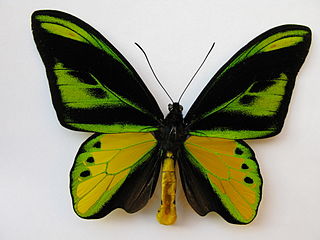
Ornithoptera chimaera, the chimaera birdwing, is a birdwing butterfly of the family Papilionidae. It is found in mountain areas of New Guinea, 1000 meters above sea level.

Ornithoptera tithonus, the Tithonus birdwing, is a species of birdwing butterfly found on New Guinea and other neighbouring islands.
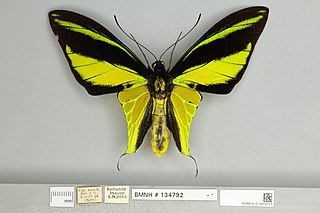
Ornithoptera meridionalis, the southern tailed birdwing, is the smallest species of the genus Ornithoptera. It is known from a handful of localities in southeast Papua, New Guinea and several localities along the south coast of Irian Jaya.

Ornithoptera paradisea, the paradise birdwing, is a species of birdwing butterfly found in New Guinea.

Troides vandepolli, the van de Poll's birdwing, is a montane birdwing butterfly occurring on Java and Sumatra. It is endemic for Indonesia and is protected by the Convention on International Trade in Endangered Species (CITES).

Troides dohertyi, the Talaud black birdwing, is a birdwing butterfly endemic to the Talaud and Sangihe islands.

Ornithoptera priamus, the common green birdwing, Cape York birdwing, Priam's birdwing, northern birdwing or New Guinea birdwing is a widespread species of birdwing butterfly found in the central and south Moluccas, New Guinea, Bismarck Archipelago, Solomon Islands, and north-east Australia.

Ornithoptera victoriae, the Queen Victoria's birdwing, is a birdwing butterfly of the family Papilionidae, found in the Solomon Islands and Papua New Guinea.

Ornithoptera croesus, the Wallace's golden birdwing, is a species of birdwing butterfly found in northern Maluku in Indonesia.

Troides andromache, the Borneo birdwing or Kinabalu Birdwing, is a species of butterfly in the family Papilionidae. It is found only in Borneo. In 2023, it was selected as the official state butterfly of the state of Sabah, Malaysian Borneo.

Atrophaneura priapus, the Priapus batwing or white-head batwing, is a swallowtail butterfly found in Burma, Malaysia, Sumatra, and Java. The subspecies A. p. hageni was named to honour Hermann August Hagen. It may be a full species.

Troides cuneifera, the Mountain Birdwing, is a large butterfly belonging to the swallowtail family, Papilionidae, found in the Thai-Malay Peninsula, Sumatra, Java and Borneo.
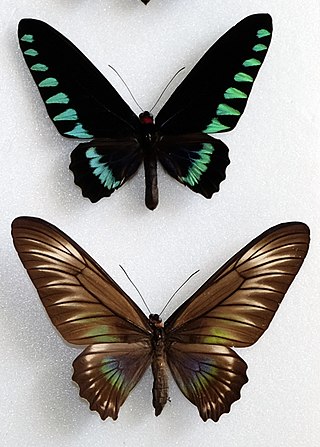
Trogonoptera trojana, the Palawan birdwing or triangle birdwing, is a birdwing butterfly of the family Papilionidae. It is endemic to Palawan in the Philippines. It is one of only two species in its genus, the other being the more widespread Rajah Brooke's birdwing, where the male has larger green markings on the hindwings. This species is included in CITES Appendix II, restricting international export to those who have been granted a permit. The wingspan is approximately 18–19 cm (7.1–7.5 in). The species may be observed flying at any point during the year. The larvae feed on Aristolochia.

Troides amphrysus, the Malay birdwing, is a birdwing butterfly in the genus Troides in the family Papilionidae.
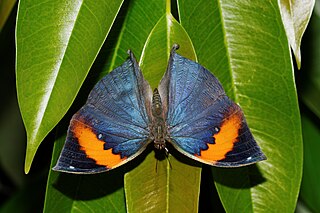
Kallima paralekta, the Indian leafwing or Malayan leafwing, is a species of brush-footed butterfly of the genus Kallima. Despite its common names, it is not found in India or Malaysia, but is endemic to Java and Sumatra of Indonesia. Like other members of its genus, it is remarkable for its strong resemblance to a dead leaf when its wings are folded. It was one of the species encountered by the British naturalist Alfred Russel Wallace in his travels in maritime Southeast Asia. It is mentioned in his famous 19th-century work The Malay Archipelago as one of the best examples of protective camouflage achieved through natural selection.

























